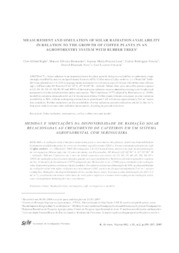Measurement and simulation of solar radiation availability in relation to the growth of coffe plants in an agroforestry system with rubber trees.
Measurement and simulation of solar radiation availability in relation to the growth of coffe plants in an agroforestry system with rubber trees.
Author(s): RIGHI, C. A.; BERNARDES, M. S.; LUNZ, A. M. P.; PEREIRA, C. R.; DOURADO NETO, D.; FAVARIN, J. L.
Summary: Solar radiation is an important factor for plant growth, being its availability to understory crops strongly modified by trees in an Agroforestry System (AFS). Coffee trees (Coffea arabica cv. Obatã IAC 1669- 20) were planted at a 3.4 x 0.9 m spacing inside and aside rows of monocrops of 12 year-old rubber trees (Hevea spp.), in Piracicaba-SP, Brazil (22°42'30"S, 47°38'00"W - altitude: 546m). One-year-old coffee plants exposed to 25; 30; 35; 40; 45; 80; 90; 95 and 100% of the total solar radiation were evaluated according to its biophysical parameters of solar radiation interception and capture. The Goudriaan (1977) adapted by Bernardes et al. (1998) model for radiation attenuation fit well to the measured data. Coffee plants tolerate a decrease in solar radiation availability to 50% without undergoing a reduction on growth and LAI, which was approximately 2m2.m-2 under this condition. Further reductions on the availability of solar radiation caused a reduction in LAI (1.5m2.m-2), thus poor land cover and solar radiation interception, resulting in growth reduction.
Publication year: 2007
Types of publication: Journal article
Unit: Embrapa Acre
Keywords: Agroforestería, Agroforestry, Agrossilvicultura, Café, Caucho, Coffea arabica cv Obatã, Coffee, Consorciação de cultura, Cultivo mixto, Desempeño del crecimiento, Fator de crescimento, Growth performance, Hevea spp, Mixed cropping, Piracicaba (SP), Radiación solar, Radiação solar, Rubber tree, Seringueira, Sistema Agroflorestal (SAF), Solar radiation, São Paulo
Observation
Some of Embrapa's publications are published as ePub files. To read them, use or download one of the following free software options to your computer or mobile device. Android: Google Play Books; IOS: iBooks; Windows and Linux: Calibre.
Access other publications
Access the Agricultural Research Database (BDPA) to consult Embrapa's full library collection and records.
Visit Embrapa Bookstore to purchase books and other publications sold by Embrapa.

